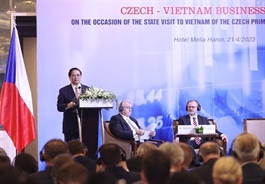Fresh foreign investment in Viet Nam up 11.1% in 4 months
Fresh foreign investment in Viet Nam up 11.1% in 4 months
Viet Nam attracted 750 new foreign-invested projects, worth over US$4.1 billion in the first four months of this year, up 65.2 per cent in the number of projects and 11.1 per cent in the level of capital, according to Foreign Investment Agency (FIA) under the Ministry of Planning and Investment.

Car tyres being produced at Sailun Vietnam Co in Tay Ninh Province. —VNA/VNS Photo Hong Dat |
The growth of the number of new projects was much higher than that of investment capital, which demonstrated that small and medium-sized foreign investors continued to believe in the country's investment environment, the FIA has said.
It added that new foreign-invested projects still focused on provinces and cities that had many advantages in attracting foreign investment including good infrastructure, stable human resources, efforts to reform administrative procedures and effective investment promotion. Among these localities were Ha Noi, Bac Giang, HCM City, Binh Duong, Dong Nai, Bac Ninh and Hai Phong.
During the period, the country allowed 386 operating projects to raise their capital by nearly $1.66 billion, up 19.5 per cent in volume but down 68.6 per cent in value.
A decline in adjusted capital in four months, however, was lower than 70.3 per cent seen in three months; 85.2 per cent in two months and 76 per cent in the first month, according to the agency.
Besides, the number of operating projects which saw capital added increased sharply instead of a modest rise of 2.6 per cent in three months and a slump of 6.3 per cent in two months. That once again confirmed investors' confidence in Viet Nam's investment environment and continued to expand their existing projects in the country, the FIA noted.
At the same time, foreign businesses were also approved to pay over $3.1 billion for capital contribution and share purchases in a total of 1,044 transactions, marking yearly increases of 70.4 per cent in value and 2 per cent in volume.
However, disbursement of foreign investment saw a slight decline of 1.2 per cent, to an estimated $5.85 billion in the period, the FIA said.
Six traditional investment partners of Singapore, Japan, mainland China, Taiwan, Hong Kong and South Korea accounted for 75.1 per cent of the country's total investment capital in January-April.
Of them, Singapore ranked first with nearly $2.2 billion, equivalent to 24.7 per cent of the total, ahead of Japan with around $2 billion or 22.1 per cent, and mainland China with nearly $752 million or 8.5 per cent.
The manufacturing and processing sector attracted the lion's share of foreign investment with over $5.1 billion, down 17 per cent year-on-year or equivalent to 57.8 per cent of the total.
Banking and finance came next with over $1.5 billion, increasing more than 12 times over the same period last year or making up 17 per cent of the total.
Real estate and wholesale and retail sectors were the runner-ups with nearly $972 million, down 65.5 per cent and $372 million, down 44.3 per cent, respectively.
During a meeting with foreign investors in Ha Noi late last week, Prime Minister Pham Minh Chinh said FDI was an important resource to contribute to promoting growth, ensuring jobs for the people.
Viet Nam would continue the effort to build a safe, transparent, and highly competitive business environment so that enterprises could feel safe and secure to invest in Viet Nam for mutual benefit, ensuring social responsibility and environmental protection, the PM said.
Viet Nam was now selective in attracting FDI with the focus placed on quality, efficiency, technology and environmental protection, PM Chinh said, adding that priorities would be given to projects in high technology, innovation, research and development, projects which enabled Vietnamese enterprises to participate in value chains, and projects which promoted digital economy, green economy, circular economy and sustainable development.
Investors would be offered the best business environment in line with OECD standards, including maintaining socio-political and macroeconomic stability, removing bottlenecks and difficulties in terms of legal institutions, infrastructure and human resources, developing supply chains, reducing transaction costs, and developing a stable, predictable policy environment with high transparency and accountability, he said.
He also urged enterprises to develop long-term business strategies in Viet Nam with a focus on sustainable development, environment protection and emerging sectors including digital transformation, green transition, circular economy, innovation, knowledge economy and climate change adaptation.






















